

Most beautiful castles. The 1,800-Km-Long Hand-Dug Grand Canal of China. The Grand Canal is a series of waterways in eastern and northern China starting at Beijing and ending at the city of Hangzhou in Zhejiang province, linking the Yellow River with the Yangtze River.
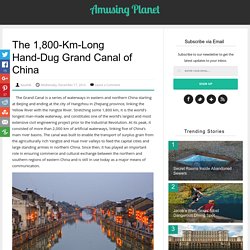
Stretching some 1,800 km, it is the world’s longest man-made waterway, and constitutes one of the world’s largest and most extensive civil engineering project prior to the Industrial Revolution. At its peak, it consisted of more than 2,000 km of artificial waterways, linking five of China’s main river basins. The canal was built to enable the transport of surplus grain from the agriculturally rich Yangtze and Huai river valleys to feed the capital cities and large standing armies in northern China. Since then, it has played an important role in ensuring commerce and cultural exchange between the northern and southern regions of eastern China and is still in use today as a major means of communication. Photo credit Photo credit Photo credit Photo credit Photo credit You may also like: Blythe Intaglios: The Nazca Lines of America. About 15 miles north of Blythe, just west of U.S.

Highway 95 near the Colorado River, are a group of gigantic geoglyphs. There are a total of six distinct figures in three locations, including a human figure at each location and animal figures depicting serpents and quadrupeds at the other two sites. The largest human figure measures 171 feet from head to toe. But from the ground level, the figures are indiscernible, nor they are visible from any nearby hill from any distance or angle. Just like Peru’s famous Nazca Lines, they can only be seen from the air.
Unseen by modern humans until the 20th century, these huge figures hidden on the desert floor were discovered in 1931 by local pilot George Palmer when flying over Blythe. The Great Gorge of the Ruth Glacier. The Architectural Grandeur of Omotesando, Tokyo. Omotesando is a tree-lined avenue located in the Harajuku and Aoyama district in Tokyo, stretching from Meiji Shrine in Aoyama-dori to Harajuku station.

Omotesando is a prime location for haute couture brands like Gucci, Prada and Louis Vuitton, but even more impressive than Omotesando’s vast collection of fashion and jewellery stores are the stunning architecturally ambitious buildings these stores occupy. Flanked on either sides are buildings with stylized glass facades, sleek angles and carefully crafted support, designed by famous architects and recipients of the Pritzker Prize, the highest possible honor an architect can get.
Omotesando is a single neighbourhood with more buildings by great modern architects than anywhere else. Its sidewalks are like fashion show ramps stalked by Tokyo’s most stylish citizens who drive Maseratis and shop at Dior. Walking down the street of “Tokyo’s Champs-Élysées” is both an impressive and humbling experience.
Audi Forum Tokyo. Taiwanese Village Transforms Itself With Cartoon Murals. Three sisters have unleashed a new life into the streets of the small Taiwanese village of Huija with a series of colourful murals.

The sisters were on a holiday visiting their grandmother about a year ago. Having nothing to do, they decided to paint the outside of her home with cartoon characters including Daruma dolls, which are a good luck charm in Japan, just to kill time. On one of the windows they painted a sign that reads: “This is where grandmother lives.” Soon other villagers of the community started copying them and painted there own walls, and before they knew it, the whole village was filled with colorful murals. Qasr al Farid: The Lonely Castle of Mada'in Saleh. Mada'in Saleh is an ancient city of pre-Islamic period located in northern Saudi Arabia, about 1,400 km to the north of capital Riyadh.
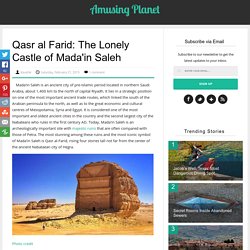
It lies in a strategic position on one of the most important ancient trade routes, which linked the south of the Arabian peninsula to the north, as well as to the great economic and cultural centres of Mesopotamia, Syria and Egypt. It is considered one of the most important and oldest ancient cities in the country and the second largest city of the Nabateans who rules in the first century AD. Today, Mada'in Saleh is an archeologically important site with majestic ruins that are often compared with those of Petra. The Eye Deceiving Murals of Quebec City. In the last 15 years, a number of fresco paintings have popped up across Quebec City, becoming a real tourist attraction and a major component of the city's urban heritage.
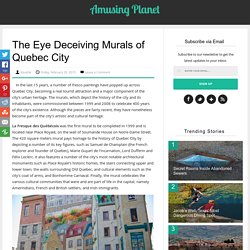
The murals, which depict the history of the city and its inhabitants, were commissioned between 1999 and 2008 to celebrate 400 years of the city’s existence. Although the pieces are fairly recent, they have nonetheless become part of the city's artistic and cultural heritage. La Fresque des Québécois was the first mural to be completed in 1999 and is located near Place Royale, on the wall of Soumande House on Notre-Dame Street. A Hidden Beach in Marieta Islands Formed by Military Bombing. Marieta Islands are a group of small uninhabited islands a few miles off the coast of Nayarit, in Mexico.

Ever since the islands was labelled a national park, there has been an increase in marine life populations due to the islands being protected from fishing and hunting by the Mexican government. Over the last few years Marieta Islands have turned into a popular tourist destination drawn by the rich fauna that include creatures like humpback whales, dolphins and manta rays. The Eye Deceiving Murals of Quebec City. The Colorful Side of Istanbul. Photographic representation of Istanbul has always been stereotypical - towering mosques, ornate palaces, old streets, markets and seagulls over the Bosphorus.
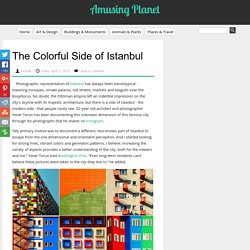
No doubt, the Ottoman empire left an indelible impression on the city’s skyline with its majestic architecture, but there is a side of Istanbul - the modern side - that people rarely see. 32-year old architect and photographer Yener Torun has been documenting this unknown dimension of this famous city through his photographs that he shares on Instagram. “My primary motive was to document a different, less-known part of Istanbul to escape from the one dimensional and orientalist perception.
And I started looking for strong lines, vibrant colors and geometric patterns. I believe, increasing the variety of aspects provides a better understanding of the city, both for the viewers and me,” Yener Torun told Washington Post. “Even long-term residents can’t believe these pictures were taken in the city they live in,” he added. Furore: An Italian Village Hidden in a Fjord. Furore is a small village located in the Coast of Amalfi, in the province of Salerno in the Campania region of south-western Italy.
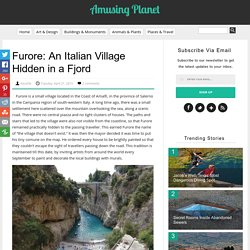
A long time ago, there was a small settlement here scattered over the mountain overlooking the sea, along a scenic road. There were no central piazza and no tight clusters of houses. The paths and stairs that led to the village were also not visible from the coastline, so that Furore remained practically hidden to the passing traveller. This earned Furore the name of “the village that doesn't exist.” It was then the mayor decided it was time to put his tiny comune on the map. Photo credit. Chan Chan: World’s Largest Adobe City. Located near the Pacific coast in the Peruvian region of La Libertad, 5 km west of Trujillo, Chan Chan was the largest Pre-Columbian city in South America and the largest earthen architecture city in the world.
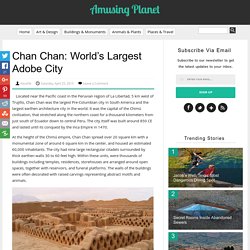
It was the capital of the Chimú civilization, that stretched along the northern coast for a thousand kilometers from just south of Ecuador down to central Peru. The city itself was built around 850 CE and lasted until its conquest by the Inca Empire in 1470. At the height of the Chimú empire, Chan Chan spread over 20 square km with a monumental zone of around 6 square km in the center, and housed an estimated 60,000 inhabitants. The city had nine large rectangular citadels surrounded by thick earthen walls 30 to 60 feet high. Within these units, were thousands of buildings including temples, residences, storehouses are arranged around open spaces, together with reservoirs, and funeral platforms. The Stone Walls of Ireland. Travelling across rural Ireland from the east to the west, one thing that arouses curiosity among many first time visitors is the hundreds of miles of stone walls that meander across farmlands in all directions as far as one can see.
These stone walls are nothing odd or unusual for the Irish population, but visitors question about them a lot. Although Ireland’s landscape is mostly green, you only have to dig a little way beneath its lush verdant carpet to discover that underneath the rolling greens lie a thick layer of hard, blue limestone. This famous blue limestone is found all over the country and it lies under more than half of the island. Ireland is mostly a rocky island composed of Carboniferous limestone formed about 370 million years ago. At that time, Ireland was part of a shallow sea between two land masses near the equator. The Mud Brick Villages of Wadi Hadramaut and Wadi Dawan. Yemen in a desert country located on the southern tip of the Arabian Peninsula, bordered by the Red Sea and the Bab-el-Mandeb Strait in the west, Saudi Arabia in the north and Oman in the east.
With the exception of the costal plains in the west, Yemen is continuously elevated with high and dry mountains having jagged peaks and plateaus covering most of the country. Yemen has no permanent rivers, but the highland regions are interspersed with several seasonal river valleys, called “Wadi”, that remain dry in the winter months. The most notable among these are Wadi Hadhramaut and Wadi Dawan, in eastern and central Yemen. Wadi Hadramaut consists of a narrow, arid coastal plain bounded by the steep escarpment of a broad plateau (al-Jawl, averaging 4,490 feet), with a very sparse network of deeply sunk wadis.
Potash Evaporation Ponds in Utah. These electric blue shapes in the brown desert are potash evaporation ponds managed by Intrepid Potash, Inc., the United States’ largest producer of potassium chloride, and are located along the Colorado River, about 30 km west of Moab, Utah. These ponds measure 1.5 square kilometers, and are lined with rubber to keep the salts in. Unlike other salt evaporation ponds that get a naturally reddish tinge due to the presence of certain algae, the bright blue color of these potash evaporation ponds come from an artificially added dye that aids the absorption of sunlight and evaporation. Once the potassium and salts are left behind, they are gathered and sent off for processing.
Photo credit. White Sands Desert, New Mexico. About 26 km southwest of Alamogordo and just south of the White Sands Missile Range, in the state of New Mexico, the United States, is an immense area of snow-white sand. But unlike other desert, the sand here is not composed of quartz, but gypsum crystals. Gypsum is one of the most common mineral compounds found on Earth but is rarely found in the form of sand, as it easily dissolves in water. Gypsum is often found in hot springs and in lake and sea water, and can occur as deposits when the water evaporates. And that’s precisely how the gypsum dunes at White Sands were formed. Photo credit The Tularosa Basin, where White Sands is located, is a shallow basin surrounded by the Sacramento and San Andres Mountains. The White Sands cover an area of over 700 square kilometers with dunes that often reach as high as 15 meters.
Unlike other desert sands, gypsum crystals do not absorb heat from the sun rays due to which they are cool to the touch. A Missile Park at White Sands Missile Range Museum. Flysch Formation in Zumaia. Flysch is a sedimentary rock formed by the alternate deposition of thin layers of silt and sandstone, found near shorelines that were rapidly experiencing changes in sea level. The Painted Dunes of Lassen Volcanic National Park. The Painted Dunes are multicolored pumice fields formed by oxidation of volcanic ash as they fell out of volcanic eruptions that have sculpted the area inside Lassen National Park in Northern California. The ash on Painted Dunes is brightly oxidized because it fell on lava flows when they were still hot. The Painted Dunes, along with Fantastic Lava Beds, and other eccentric geological features lie near Cinder Cone, a 700-foot tall cinder cone volcano that’s believed to have last erupted in 1650s.
The Enchanted Highway, North Dakota. The Comic Book Route in Brussels. Ferropolis: The City of Iron. Speicherstadt, The Historic Warehouse District of Hamburg. The Fortified Towns of M'Zab Valley. The Great Polish Map of Scotland. Todra Gorge of Morocco. The Shiprock of New Mexico. Ruhr’s Slag Heap Tourism. Scars of World War I: The Battlefield of Beaumont-Hamel.
The Hindenburgdamm Causeway. Dasht-e Kavir, The Great Salt Desert. The Strange Beauty of Soviet Bus Stops. The Lost Pink and White Terraces of Lake Rotomahana. The Lost Pink and White Terraces of Lake Rotomahana. The Mysterious Desert Kites. Oregon's Lost Lake Disappears Each Summer Down a Hole. Monte Kali: A Mountain of Table Salt. The New Croton Dam And Spillway. ‘Trans Am Totem’ And ‘Spindle’: The Art of Stacking Cars. Timgad: An Ancient Roman City With a Very Modern Grid Design. The Granite Dells of Prescott, Arizona. The Murals of Invergordon. Elephant Foot Glacier. Musical Roads That Play Melodies When Cars Drive Over. Dig Your Own Fossils at These Quarries. The World Map at Lake Klejtrup. The Realmonte Salt Mine in Sicily. The Ginkgo Avenue in Tokyo. The Sculpted Hedges of Schönbrunn Palace. Devil’s Slide, Utah. The Mysterious Stone Columns Along Crowley Lake. Iceland’s Most Beautiful Waterfalls.
The Hall of Mosses. The Painted Cliffs of Maria Island. World’s Most Beautiful And Outstanding Piers. The Belogradchik Fortress, Bulgaria. The Coloured Canyon of Egypt. Shushtar Historical Hydraulic System. The Ghost Town of Bodie. The Alien Landscape of Bisti Badlands. The Bridges of Prague. The Walls of Avila. Want to Spend a Night in Van Gogh's Bedroom?